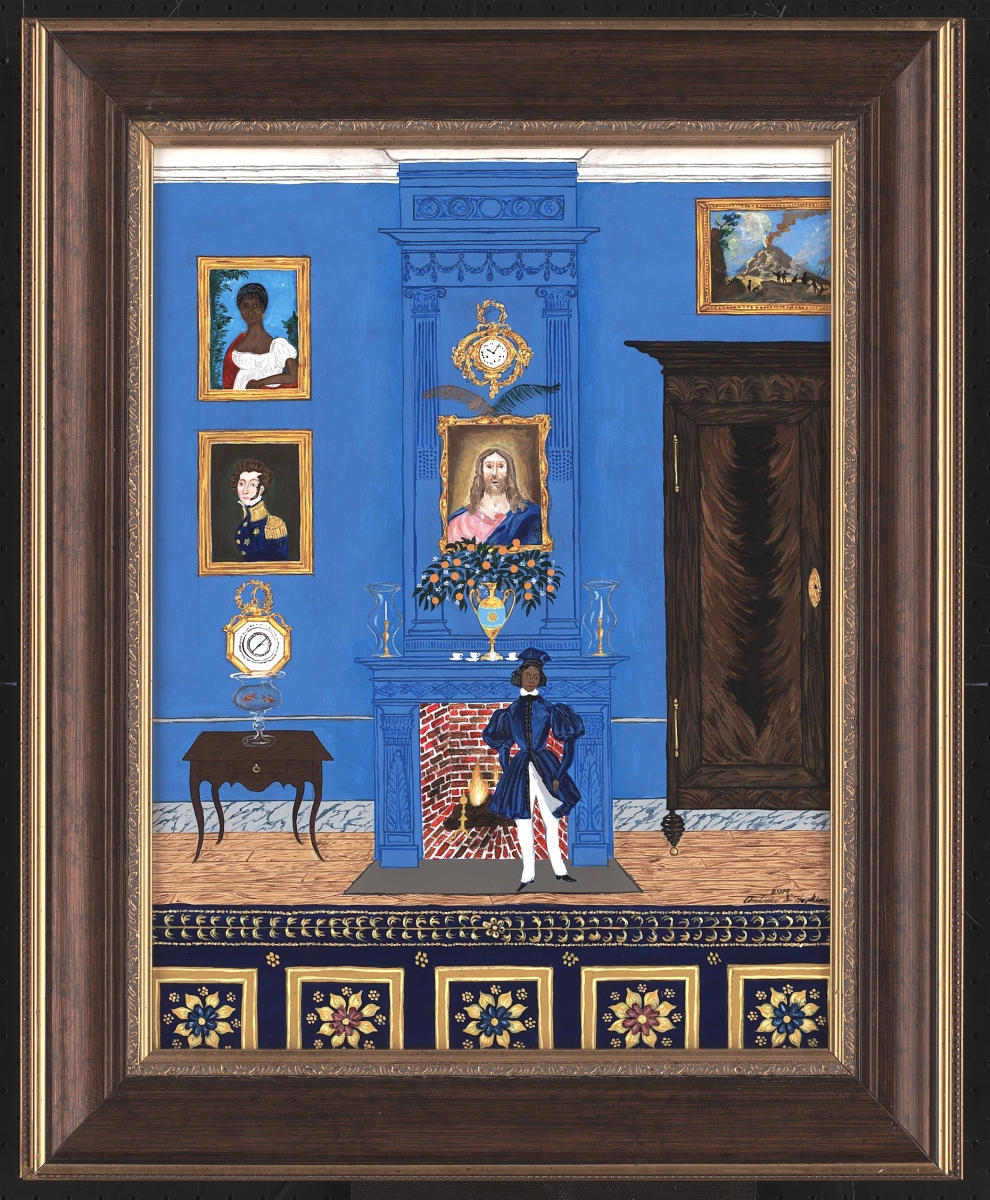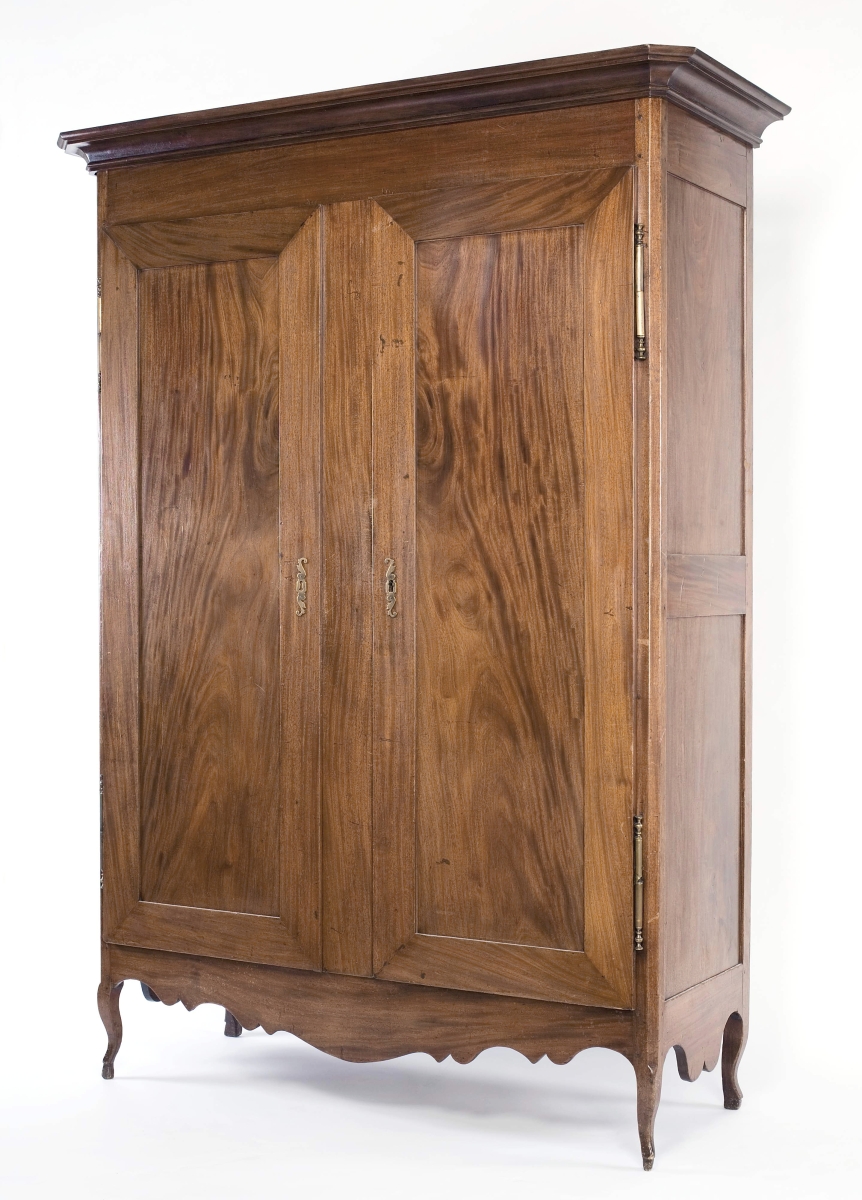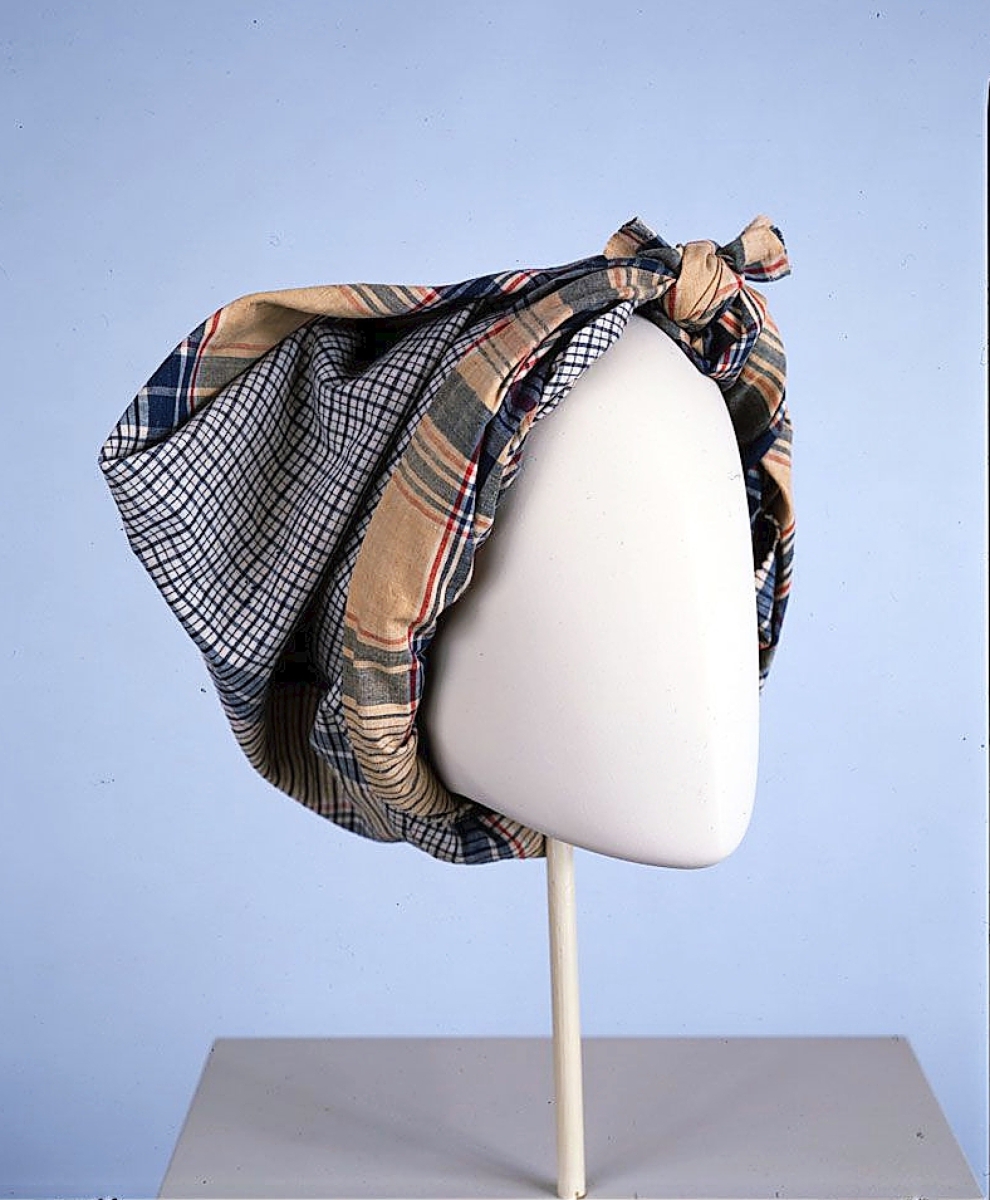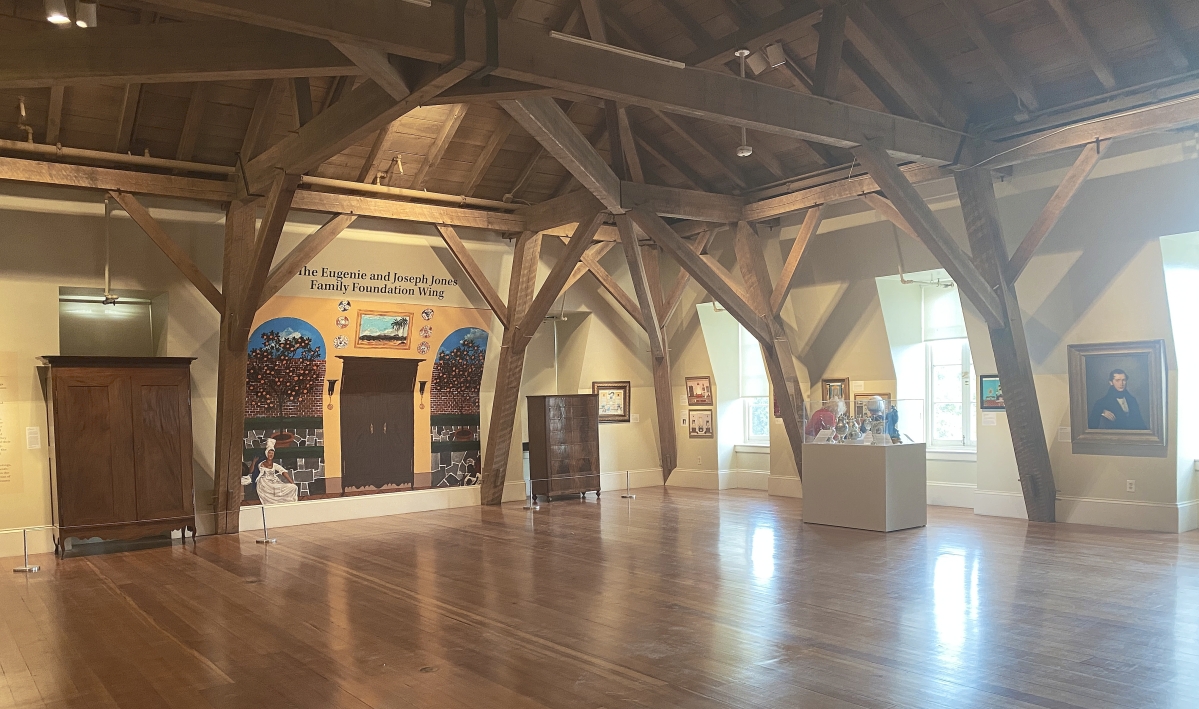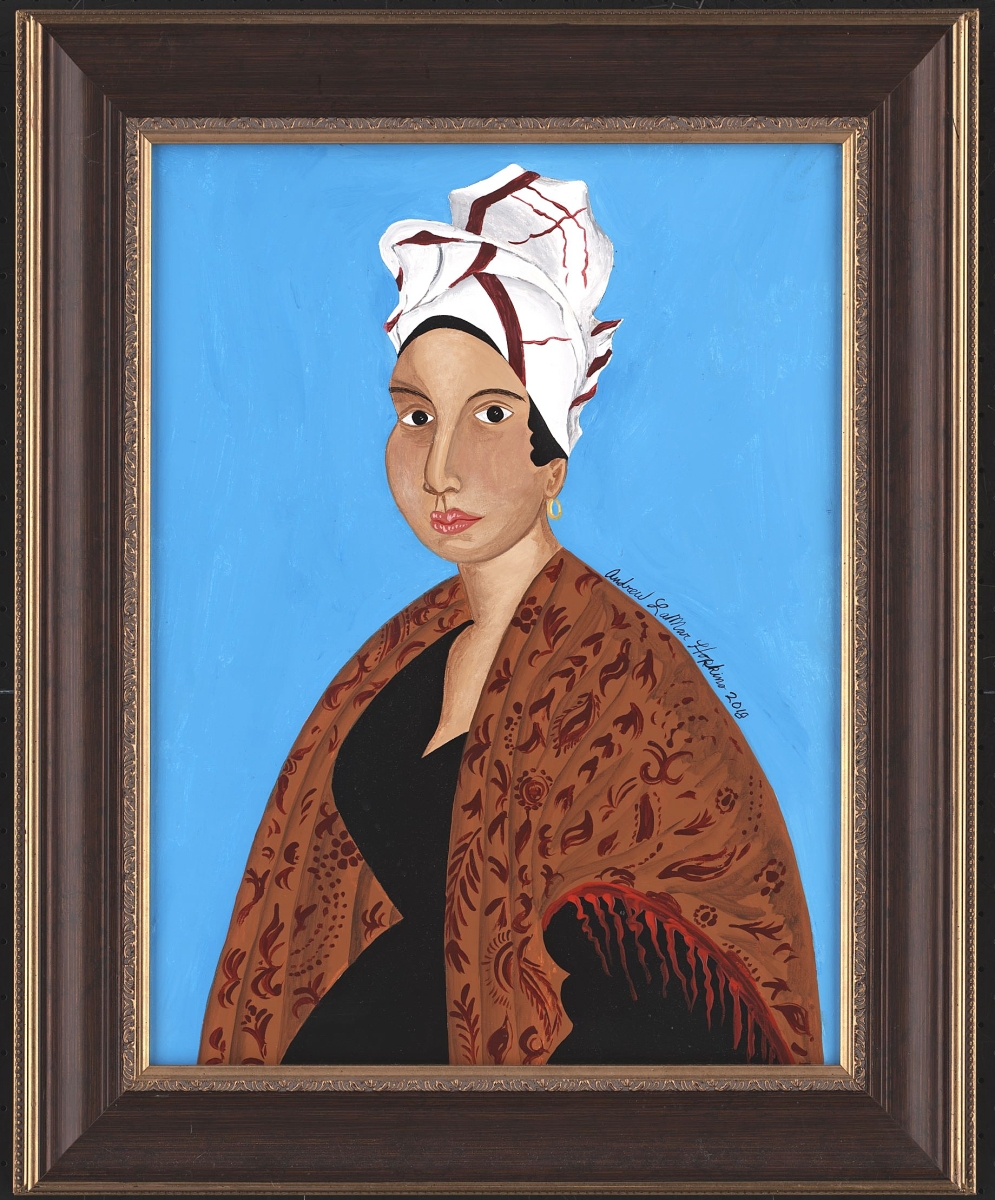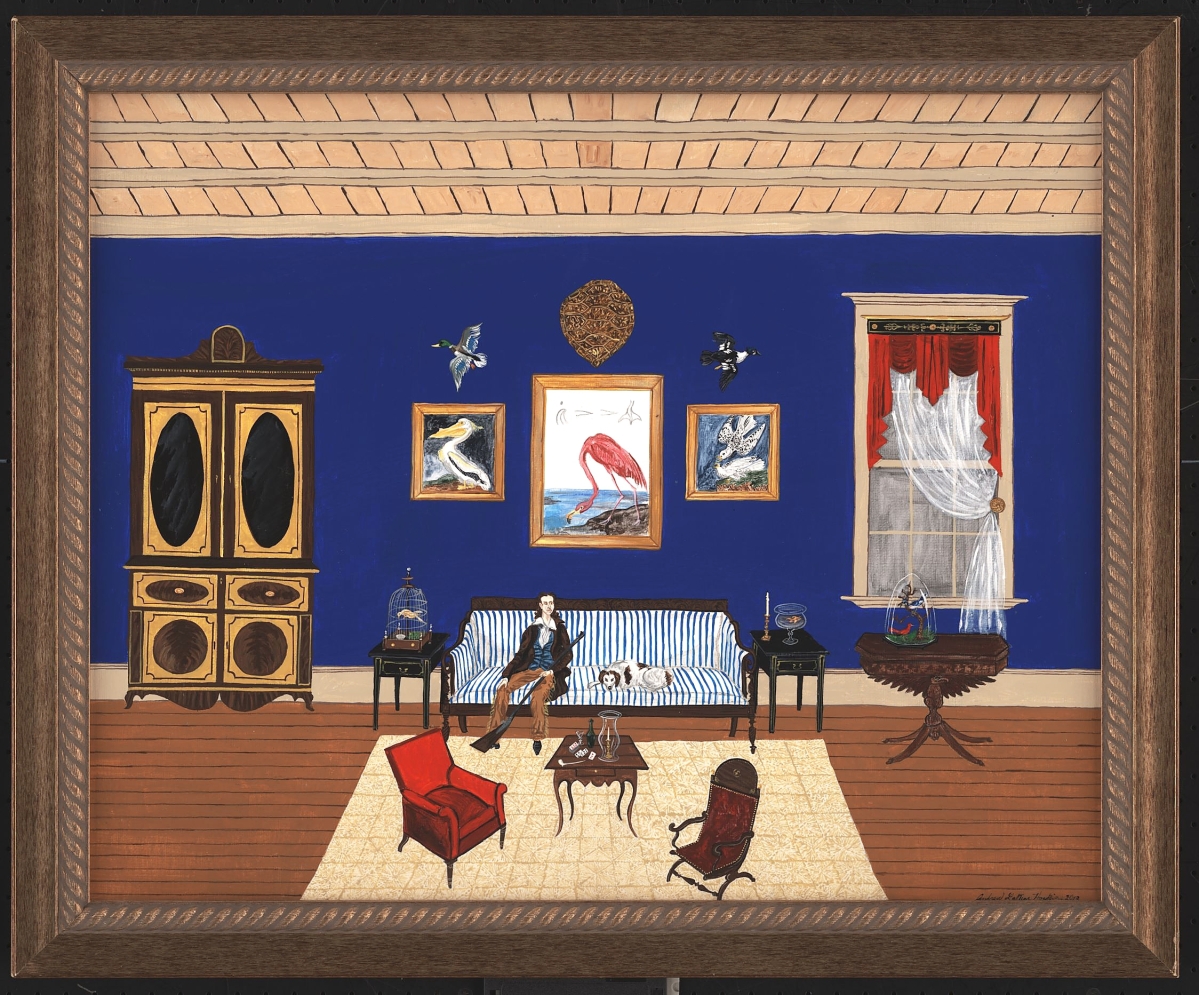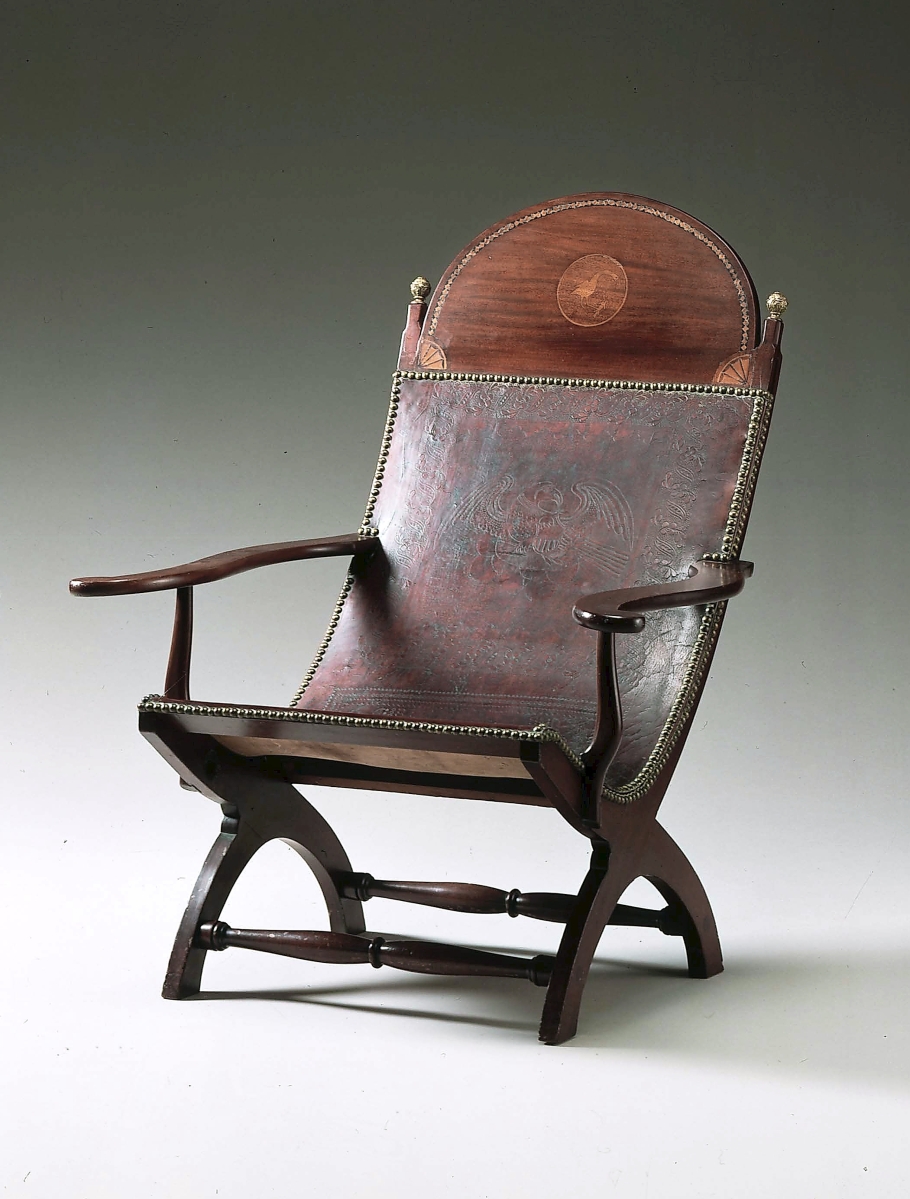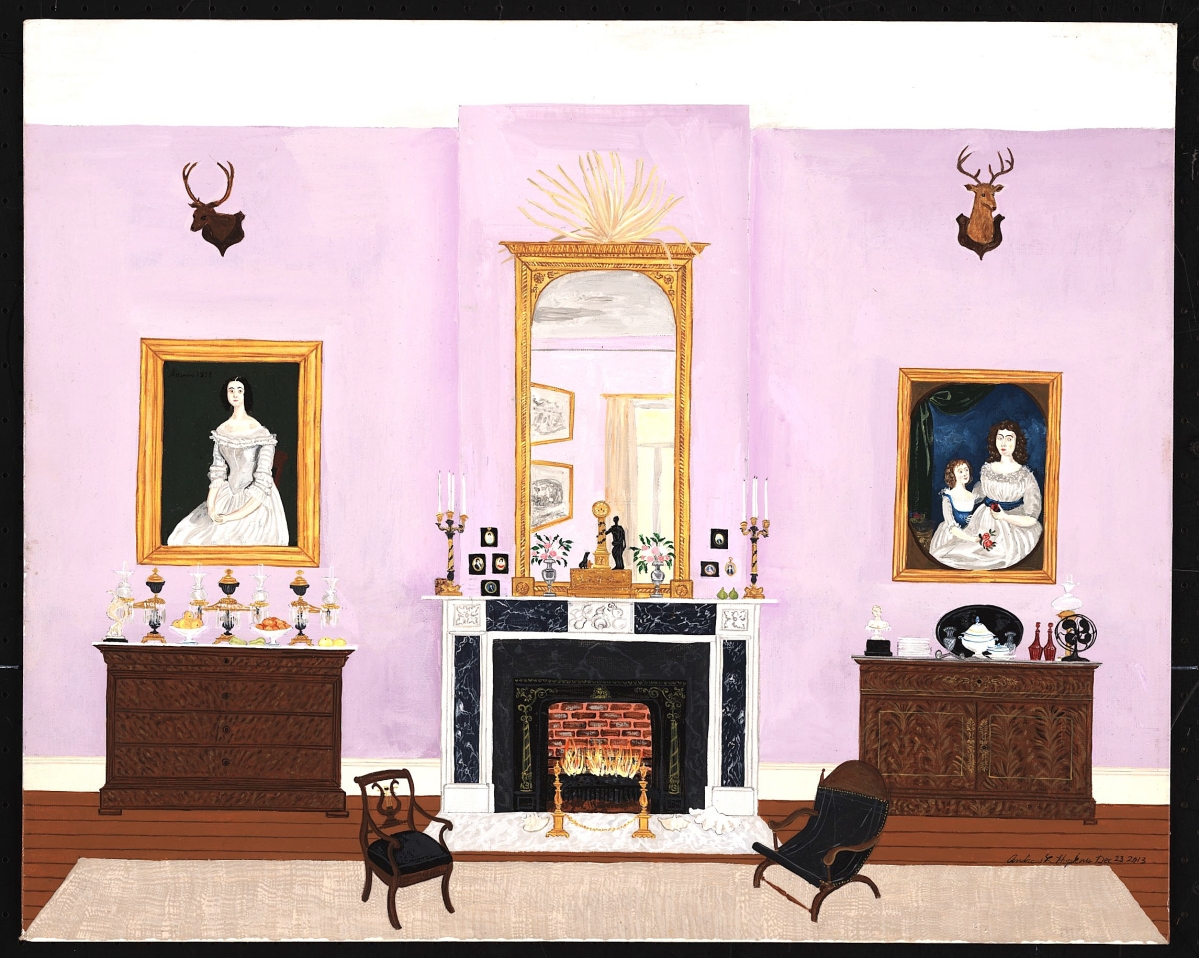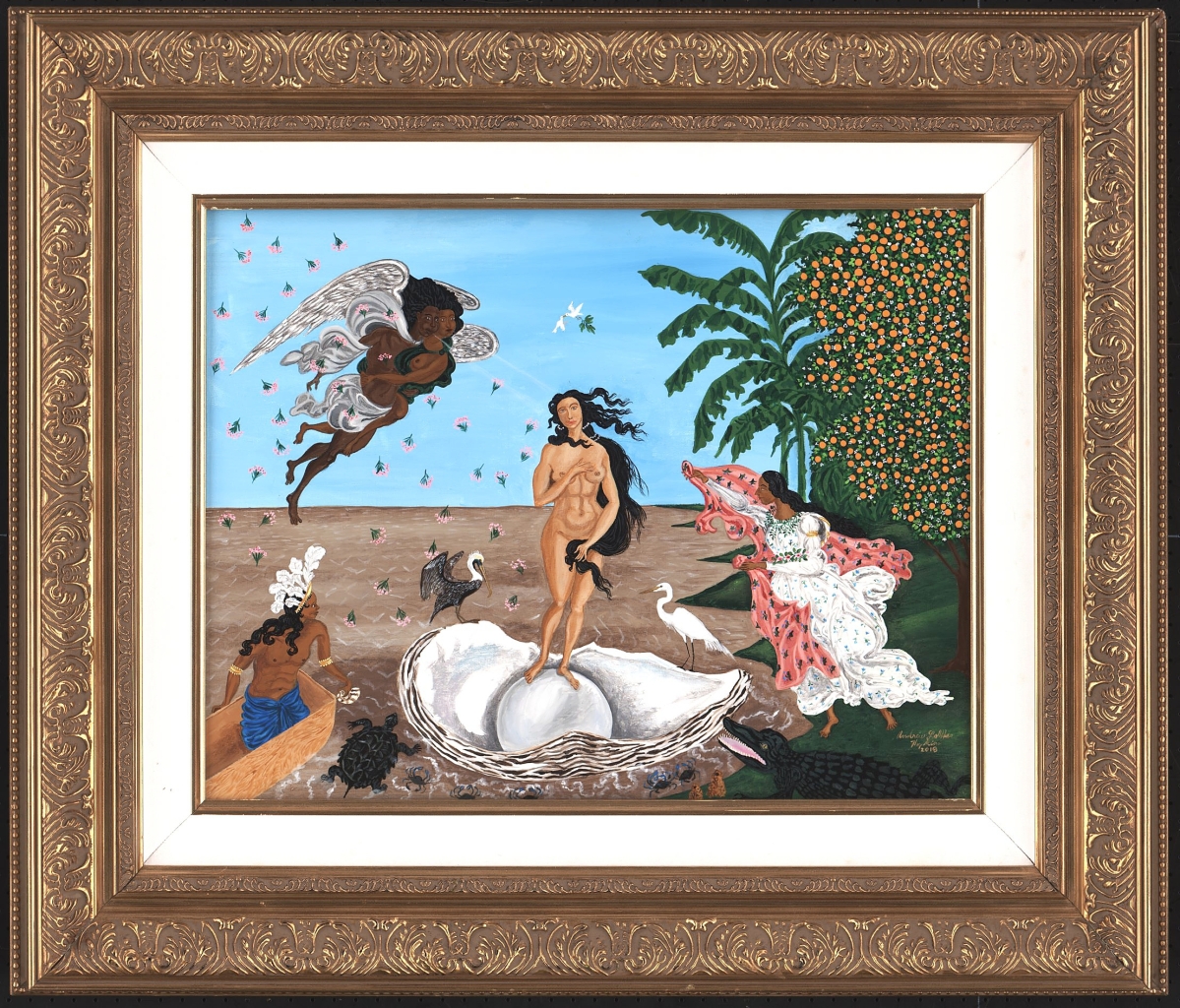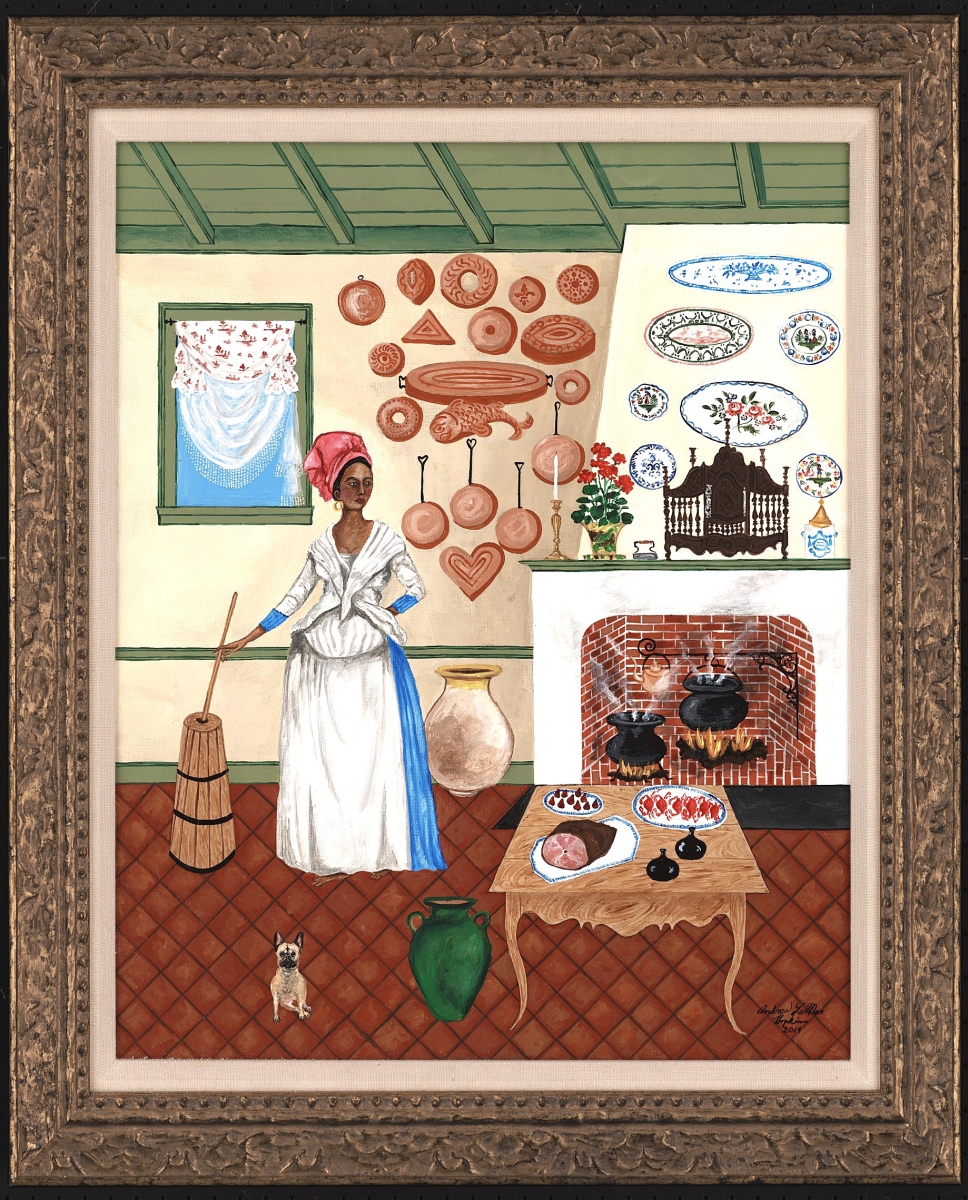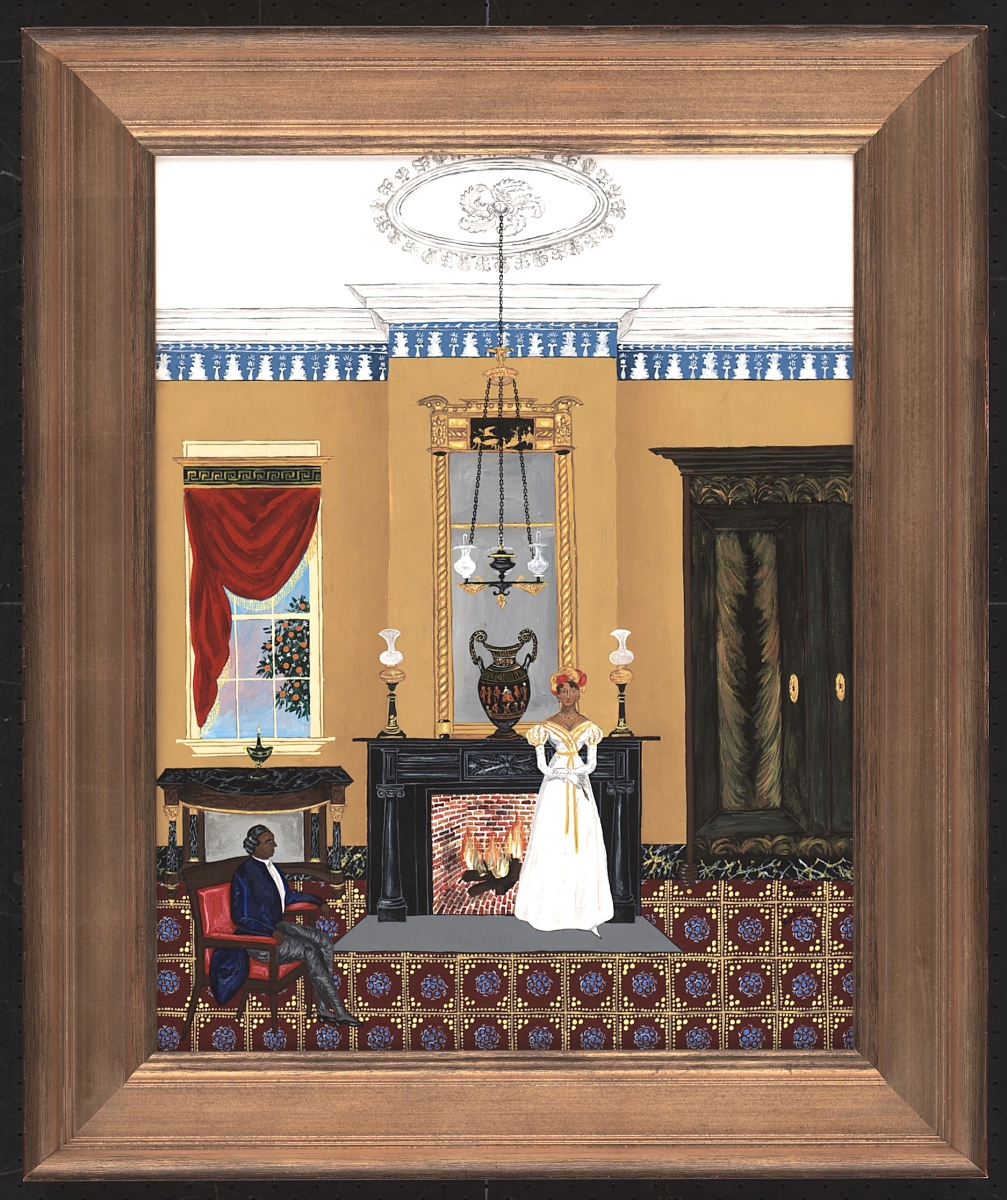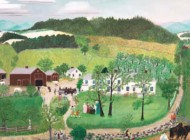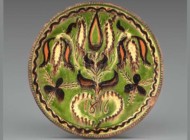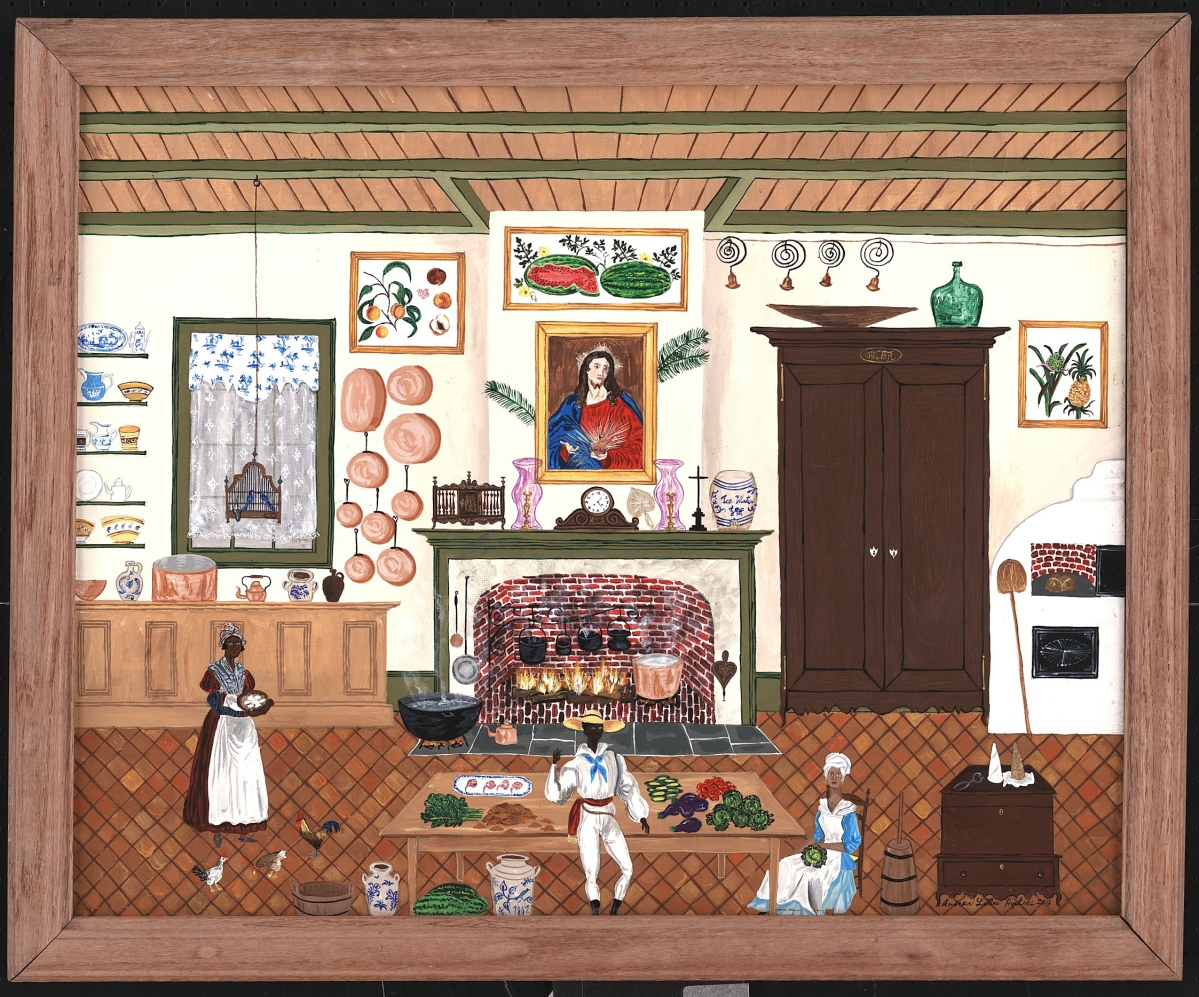
“Creole Kitchen” by Andrew LaMar Hopkins, 2013, acrylic on canvas, 16 by 20 inches. Loaned by Rick Ellis.
By Karla Klein Albertson
NEW ORLEANS, LA. – So much has been written in the last few years about Louisiana artist Andrew LaMar Hopkins (b 1977) – the phrase “meteoric rise” pops up – that fascinated readers feel like they know him, yet they may have seen only a few of his works. Now, for the first time, an exhibition of more than 70 paintings – complete with catalog – is on view in New Orleans through mid-September 2023 at the Cabildo, part of the Louisiana State Museum system.
When we view historic portraits or populated paintings of the past, we gain information about how material culture surrounded and softened life. Sometimes the furniture is as fascinating as the faces. Hopkins, although a self-taught painter, fills his canvases with period detail – decorative arts and costumes – which betray his fondness of early Nineteenth Century surroundings.
John Berendt, author of the classic southern novel, Midnight in the Garden of Good and Evil, wrote an Artist Profile in the March 2022 issue of The Magazine Antiques, which stated, “His imagination and sense of humor, too, come into play, of course, but his departures from strict reality are tempered by a faithful representation of architectural details, interior decor, furniture, fashions and even the vegetation seen in his paintings. They are all rigorously accurate down to the last window trim or turban, which is a result of his passion for antiques and history from the age of nine.”
Therefore – although the Cabildo does not usually do single-artist shows – Hopkins was a perfect fit in every way because the institution has the antique artifacts to accompany the paintings and is located at the heart of Creole life. Organizing and curating the exhibition were two women: museum historian Joyce Miller and Polly Rolman-Smith, the director of furniture and decorative arts at Neal Auction Company, who in 2020 and 2021 served as the director of curatorial services at the museum.
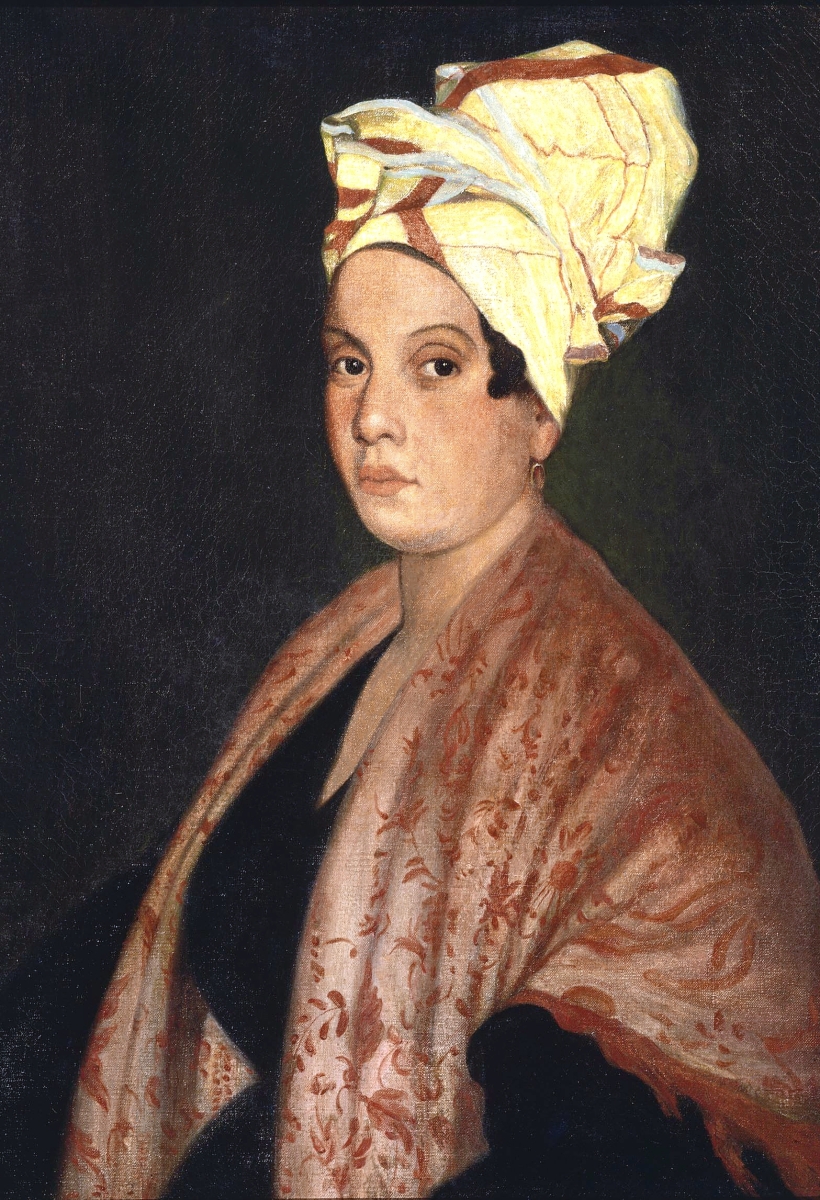
Portrait previously identified as Marie Laveau by Frank Schneider, circa 1915, oil on canvas. This painting by Louisiana State Museum employee Frank Schneider was once believed to be a portrait of Marie Laveau and is the basis of Andrew LaMar Hopkins’s portrait of the Voodoo priestess. Though almost no evidence supports this conclusion, the portrait continues to be associated with Laveau.
Schneider’s portrait is a copy of a painting by an unknown artist that was on loan to the museum from about 1911 until the early 1920s. Shortly after the painting was returned to its lender, its whereabouts went unknown. In its absence, Schneider’s portrait became the iconic representation of the historical figure and is often associated with Laveau in popular culture. In 2022, the original portrait resurfaced and was purchased by the Virginia Museum of Fine Arts.
In a conversation with Antiques and The Arts Weekly, Miller said they had the full support of the Louisiana Museum Foundation, one of the museum’s support groups. “They said, we think this would be a great exhibit.” When the show opened on November 18, the show became the theme of their annual fall celebrations including a costume ball. Then “Le Gouter with Desiree,” a French afternoon tea, was attended by Desiree Josephine Duplantier, Andrew LaMar Hopkins’ alternative female persona. Her chic black costume with pearls and a fan as well as ball photos can be seen on the foundation website www.thelmf.org. Exactly the combination of fine music, dancing and food that New Orleans offers the world.
To gather the necessary exhibition pieces, Miller and Rolman-Smith sought out loans from collectors with help from the artists, eventually ending up with works from about 30 different lenders. The historian said of the exhibition, “People will be surprised. His work gives a clear sense that there was a strong community of free people of color in New Orleans in the 1820s-40s that, in spite of the limitations placed on them, led incredible lives – Andrew really captures that period.”
Curator Rolman-Smith was happy to answer more questions about the genesis of the show. “I originally met Andrew through Neal Auction. As an antiquarian, he was regularly attending our auctions and would often make an appearance at the auction preview parties as Miss Desiree Josephine Duplantier, his drag alter ego. His art started gaining more attention around this time and then right as the pandemic hit, he blew up! It seemed like every major national publication was doing an article about Andrew’s spectacular paintings of antebellum Creoles. I was working at the Louisiana State Museum and remember reading the lengthy 2020 New York Times profile on Andrew and immediately thinking, ‘We need to do an exhibit ASAP!'”
Rolman-Smith felt the goals were clear. “The primary goal of the exhibition was to contextualize Andrew’s work alongside relevant period objects from the permanent collection of the Louisiana State Museum. Since Andrew paints dynamic scenes of early Nineteenth Century Creole life in New Orleans, he incorporates paintings, furniture, architecture and decorative objects from this period and region within his canvases. Many of the objects in his paintings are actual items from the museum’s collection, so this exhibit was also an obvious opportunity to showcase some of the museum’s most important pieces.”
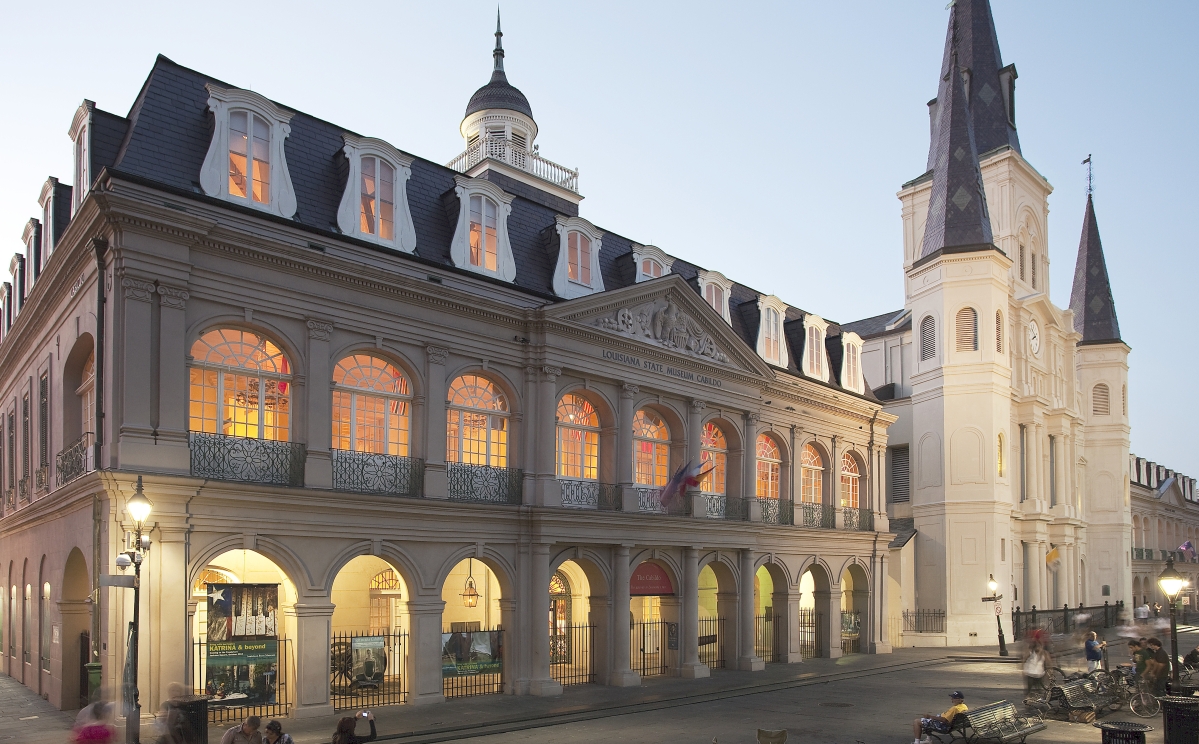
The Cabildo, New Orleans, Jay Rosenblatt photo.
“Joyce and I both thought it was important to give the viewer a broad understanding of what the term ‘Creole’ means within New Orleans history, since this term means a lot of different things to different people and places. ‘Creole’ is not only a distinctive culture rooted in the confluence of African, European and Indigenous peoples in Louisiana, but is also a lifestyle and identity celebrated by Andrew in his art and everyday life.”
In fact, the first sections of the show attempt to deal with what it means to be Creole – a term not easily defined. Hopkins himself traces his Creole heritage back to a French ancestor. New Orleans was a cosmopolitan hub in the Nineteenth Century where French, Spanish and English residents regularly interacted with free people of color.
To quote the exhibition’s wall text, “Hopkins generally depicts the upper crust of Creole society and celebrates the elegance and beauty of the world they created. While his subjects include individuals of various racial identities, the artist’s focus is on mixed-race and Black Creoles in the 1820s and 1830s New Orleans, many of whom were free people of color.”
When asked if she has favorites in the show, Rolman-Smith responded, “I am a furniture and decorative arts person, so I adore his interior scenes, which are truly a survey of art and decorative arts history of the early Nineteenth Century. I really love his attention to detail in each piece, down to the mahogany figuring of an armoire or the marble veining on the tile floor.
“I also really love pieces like ‘Creole Apothecary’ and Andrew’s depictions of Rose Nicaud, who was a free woman of color and coffee vendor in New Orleans. These pieces highlight the ingenuity of the Creole people of the city.” Hopkins also does portraits of historical figures, including Marie Laveau and John James Audubon, who had a Creole background. He is pictured in his salon with his famous flamingo illustration on the wall, an example of which is also in the show.
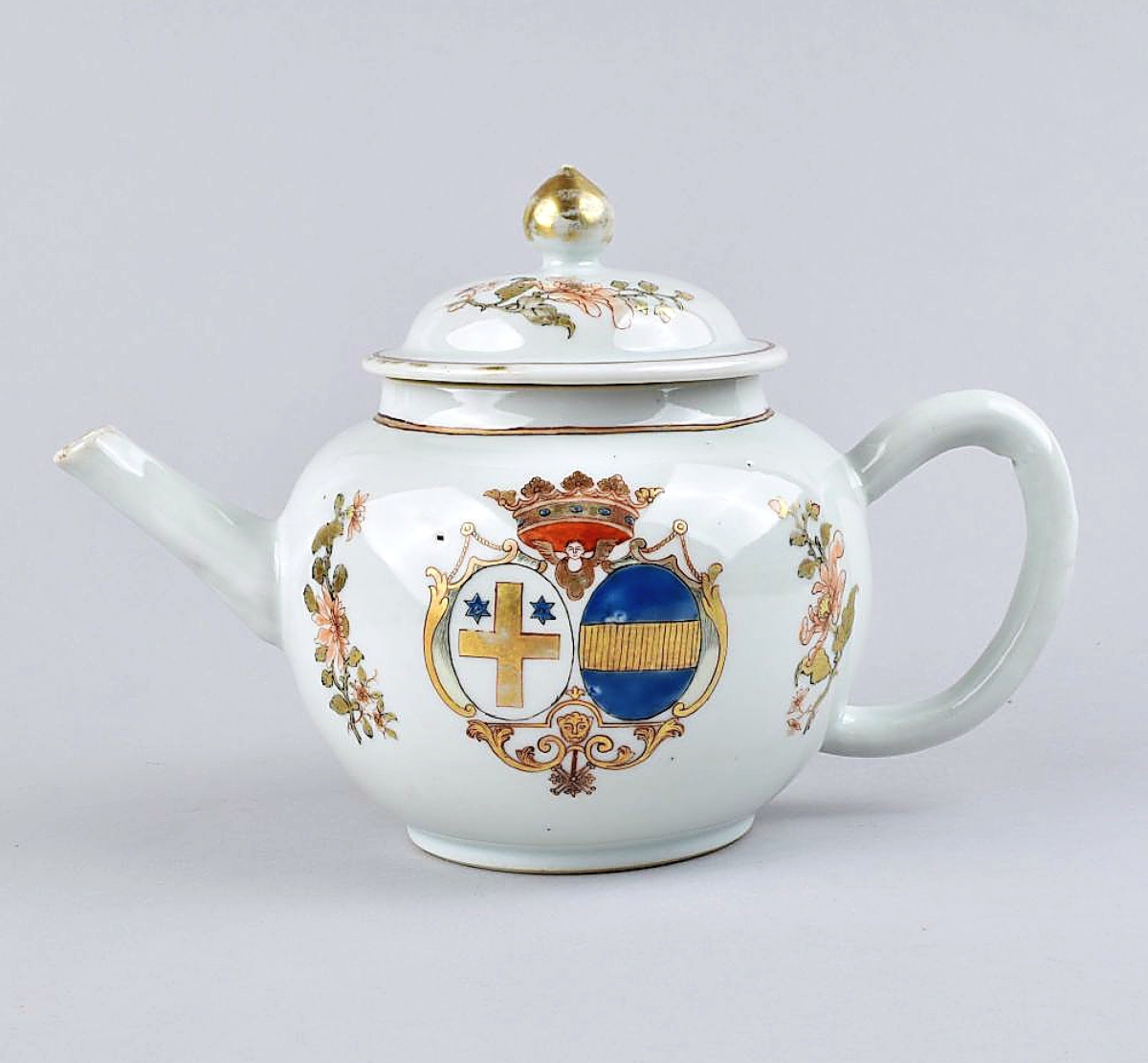
Teapot owned by Louis Billouart, Chevalier de Kerlérec, circa 1750, porcelain. Purchased by the Louisiana Museum Foundation with funds provided by the Buddy Taub Foundation, Dennis A. Roach and Jill Roach, directors. Made by an unidentified Chinese artist, this teapot is believed to have been created for Louis Billouart, Chevalier de Kerlérec, a French naval officer who served as governor of Louisiana from 1753 to 1763. It features the Kerlérec family coat of arms. During the Eighteenth Century, many wealthy Europeans commissioned Chinese artists to create and export armorial porcelain like this teapot. Some of them brought these pieces with them to the New World and handed them down to their Creole descendants.
Asked what she wanted people to learn from the exhibition, the curator replied: “I hope visitors will come away with a better understanding of the vibrant and interesting community of free people of color, who Andrew emphasizes within his depictions of New Orleans Creoles, who have long been overlooked by traditional history. There are so many fascinating stories from this period and Andrew’s art beautifully portrays these stories like never before.”
In Neal Auctions’ June 2021 sale, “Louisiana Gentleman’s Chamber,” an 11-by-14-inch work painted in 2013 and an excellent example of Hopkins’ style, brought $19,200 (it had been estimated at $12/15,000). Marney Robinson, who heads fine art at the firm, told the Antiques and The Arts Weekly, “I’ve always thought Andrew was doing something very unique that was personal and tied to his own heritage. He has a passion for antiquities. His paintings are historical, and they really do tell a story – every detail is included for a reason. They’ve provoked thought on the complexity of identity in Creole cultures. Louisiana history is very multifaceted, it’s intersectional, and I think his work really falls in the middle of all that. As more people have learned about him, everyone would love an Andrew Hopkins painting – no question. They’re just charming, and I couldn’t be happier for him – very well deserved. ”
Collectors may be interested in following the market for Hopkins’ paintings and reading through biographical articles online. The hardcover catalog, Creole New Orleans, Honey: The Art of Andrew LaMar Hopkins, features seven scholarly essays and close to 100 illustrations has just come out (Hardcover $65). Order from the Louisiana Museum Foundation or from online booksellers.
“Creole New Orleans, Honey: The Art of Andrew LaMar Hopkins” will be on view at the Cabildo through mid-September 2023.
The Cabildo New Orleans, part of the Louis State Museum system, is at 701 Chartres Street. For more information, www.louisianastatemuseum.org/museum/cabildo or 504-568-8975.

